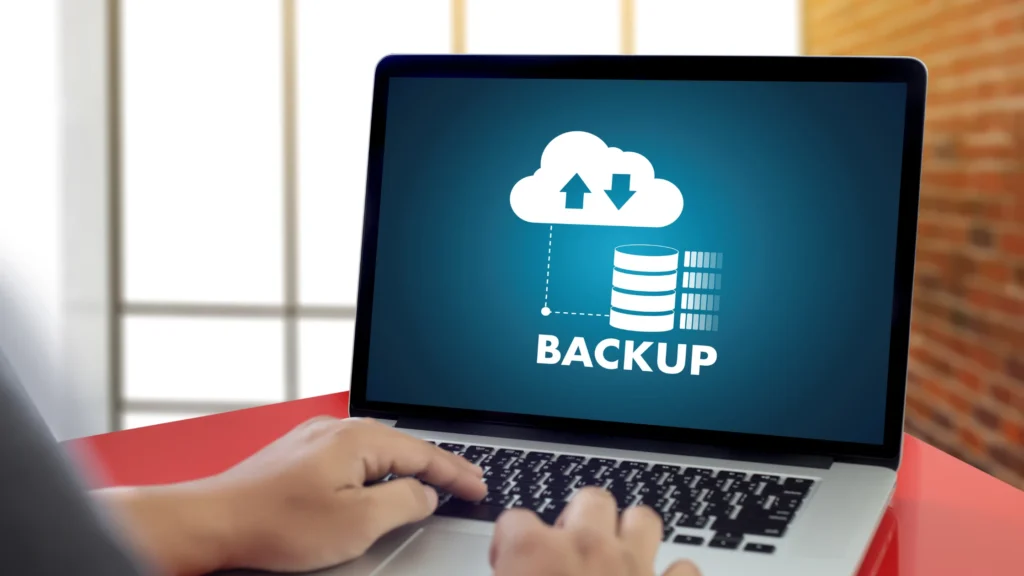As a website owner, we’re sure you know the real cost of failing to back up your website data, so we hope you have done so. But still, you could be among the many website owners who keep doing it wrong, most of the time.
You build, post, and sell online, but one small website backup mistake can erase everything. A single server failure, human error, or ransomware attack causes total data loss and hours of website downtime.
The truth is, backup problems don’t just affect big companies. They hurt SMBs, enterprises, e-commerce websites, and even small blogs. That’s why a strong website backup strategy isn’t optional; it’s survival.
Here are the nine biggest website backup mistakes you might still be making, and how Cloudoon vault fixes them through automated cloud backups, encryption, and reliable disaster recovery.
1) Not Having a Website Backup Strategy at All
Many site owners believe their site is too small to target. That’s the first mistake. Without a website backup plan, you’re gambling with your data. A simple plugin update can break your site. A server crash can erase months of work.
When data loss happens, the cost isn’t just financial. You lose customer trust, traffic, and time. Without backups, rebuilding can take days or even weeks, and each minute of website downtime costs money and reputation.
A strong disaster recovery plan starts with regular backup frequency. With Cloudoon Vault, you can automate backups daily, weekly, or in real-time. Every backup is verified, stored in secure cloud storage, and protected by AES-256 encryption.
Cloudoon Vault’s 99.99% uptime guarantee means your data stays online and ready when you need it. That’s real data protection, not luck.
2) Relying on Your Hosting Provider’s Backup Alone

Relying only on your hosting provider is like leaving your car keys in the ignition and hoping no one drives off.
Many hosting providers offer basic backups, but they’re often untested, stored on the same server, and not part of your business continuity plan. If a server failure or ransomware hits, you lose both your live site and your backup.
Cloudoon Vault eliminates that risk with offsite backup in secure, redundant data centers. It uses multi-region redundancy, meaning copies of your website files and database backups are stored in multiple locations across the globe.
Even if one region fails, your backups remain safe and accessible to global website users.
3) Using the Wrong Backup Frequency
Not all websites need the same backup frequency. But using the wrong backup frequency can cause massive data loss.
A small business website might do fine with daily backups, but an e-commerce website needs real-time backup monitoring to capture every transaction. The wrong setup means losing orders, payments, and customers.
With Cloudoon Vault, your backup frequency setup is flexible. You can choose daily, weekly, or real-time schedules, depending on your website type and traffic level. Each backup is stored in encrypted cloud storage and verified automatically.
By setting the right frequency, you improve your recovery point objective (RPO) — how much data you can afford to lose, and your recovery time objective (RTO) — how fast you can get back online.
4) Not Testing or Verifying Backups Regularly
We know you’re assuming your website backups work. Then comes the crash, and you discover your last backup was corrupted. Why?
You did not do backup testing and backup verification. Backups that aren’t tested often fail when you need them most. A failed website restore process can cause panic, lost hours, and damage to brand reputation.
Cloudoon Vault fixes this by automating the backup testing process. It runs verification checks after each backup, confirming data integrity and alerting you to any problems. You can also run test restores to make sure your data recovery process works in minutes, not hours.
5) Keeping Backups on the Same Server
It’s one of the oldest common backup errors to store your website data backups on the same server as your live site.
If that server fails, both your website and your backup vanish. It’s like keeping your spare key in a locked car. Human error, hardware crashes, or ransomware can wipe everything instantly.
The fix? Offsite data storage. Cloudoon Vault automatically stores your backups in secure cloud storage, separate from your host. This ensures your data recovery is always possible, even during total server failure.
Each file is encrypted using AES-256 encryption level and replicated across multi-region redundancy centers. Whether you’re in Africa, Europe, or the U.S., your website files stay safe and ready to restore anytime.
6) Ignoring Encryption and Security Settings

As a website owner, you may skip encryption, thinking backups aren’t attractive targets. That’s a huge mistake.
Hackers love unprotected backups. They contain complete databases, logins, and user data. If stolen, the business impact can be severe. We’re talking about lost trust, reduced traffic, and even legal issues.
With Cloudoon Vault, every backup is protected with AES-256 encryption, both during transfer and at rest. It meets compliance standards like GDPR and HIPAA, giving you global protection and peace of mind.
The system also features backup automation tools that constantly monitor, encrypt, and verify your backups. This eliminates the need for manual steps and ensures complete website security.
7) Forgetting to Include Database and Dynamic Files
As users, we mostly only back up static pages, forgetting about our database backups and plugins.
This mistake leads to partial recovery; the site looks fine, but doesn’t work. Missing databases mean missing users, content, and orders. That’s an incomplete data recovery, which can slow your website recovery time.
Cloudoon Vault automatically detects all website files, databases, and custom folders in your CMS (like WordPress, Joomla, or Drupal). Each backup includes dynamic data, configuration files, and uploads, everything your site needs to run.
No more failed website restore moments. Just a complete, working website every time.
8) Not Setting a Proper Data Retention Policy
Are you among website owners who keep just one or two backup versions? But what happens if that one backup is corrupted?
A smart data retention policy stores multiple versions over time. This allows you to restore an older version if something breaks after an update.
With Cloudoon Vault, you can choose your retention period, 7, 30, or 90 days, depending on your business needs. The system keeps your backups clean, organized, and easy to retrieve.
It also reduces recovery cost and improves your long-term business continuity plan by giving you complete control over which versions stay and which get removed automatically.
9) Skipping Backup Automation Altogether
Manual backups rely on memory, and people forget. A missed backup before a crash means total data loss.
Skipping backup automation creates huge business continuity risks. If backups aren’t enabled, they’re easy to ignore, leaving your site vulnerable to human error, data loss, or attack.
Cloudoon Vault keeps backup automation enabled 24/7. It runs backups automatically, even when you’re asleep, and uses real-time backup monitoring to detect failures before they happen.
This automation reduces website downtime cost, improves data recovery time, and ensures your site’s uptime guarantee stays above 99.99%. Its reliability made simple.
How Cloudoon Vault Fixes Every Backup Mistake
When you combine automation, encryption, and offsite backup, you remove almost every point of failure. Cloudoon Vault does precisely that; it simplifies backup and recovery for global website users.
Here’s how Cloudoon Vault solves the most common website backup mistakes.
- Automated Backups: Runs daily, weekly, or real-time without human input.
- Secure Cloud Storage: All data is protected with AES-256 encryption.
- Multi-Region Redundancy: Keeps copies in multiple server locations worldwide.
- Disaster Recovery: Rapid data recovery process in minutes, not days.
- Backup Testing & Verification: Every backup is tested for data integrity.
- Flexible Retention Periods: Choose from 7, 30, or 90 days of stored versions.
- Compliance Standards: Built-in GDPR and HIPAA adherence.
- Low Recovery Cost: Avoid expensive external recovery services.
- High Reliability: Uptime guarantee of 99.99% for total data protection.
Whether you manage small or medium businesses, enterprises, or e-commerce websites, Cloudoon Vault keeps your business continuity plan strong.
You don’t have to be a tech expert. You need to stop making the same backup mistakes and trust automation to secure, replicate, and protect your work.
Final Thoughts
You can’t control server failures, human error, or cyberattacks. But you can control your response.
Avoiding common backup errors isn’t about luck; it’s about the right tools. Cloudoon Vault combines secure cloud storage, automated backups, and encryption to protect everything you’ve built.
Don’t wait for data loss to remind you why backups matter. Start today.
Website Backup Mistakes FAQs
1. What are the most common website backup mistakes?
The most common website backup mistakes include not having a backup plan, storing backups on the same server, skipping encryption, and failing to test backups.Cloudoon Vault solves all these by automating backups, encrypting data, and verifying every restore point.
2. How often should I back up my website?
How often you back up your website depends on your website type. Blogs and small business sites can use daily backups, while e-commerce stores need real-time backup monitoring to protect transactions.
3. Is it safe to rely on my web host’s backups?
It’s not entirely safe to rely on your web host’s backups. Hosting backups are often stored on the same server and may fail during server outages or ransomware attacks. It’s safer to use offsite backup storage like Cloudoon Vault, which keeps encrypted copies of your data in multi-region cloud storage for guaranteed protection.
4. What happens if my website backup fails?
If your website backup fails or becomes corrupted, you risk losing your entire site during a server crash or data loss event. Cloudoon Vault prevents this through backup verification, where each backup is automatically tested to ensure full data integrity.
5. Why should backups be encrypted?
Encryption keeps your backups secure from hackers. Without it, your stored data, such as logins, user info, and databases, is vulnerable to theft. Cloudoon Vault uses AES-256 encryption to protect your backups both during transfer and at rest, meeting GDPR and HIPAA standards for data privacy.
6. What’s the difference between on-site and offsite backups?
On-site backups are stored on the same server or local device, which makes them faster but less secure. Offsite backups, like those in Cloudoon Vault, are stored in remote cloud storage, ensuring your data remains safe even if your server or location fails.
7. How does Cloudoon Vault improve disaster recovery?
Cloudoon Vault provides disaster recovery through multi-region redundancy, automated backups, and real-time restore options. In case of a crash, you can recover your whole website in minutes, reducing downtime and protecting your business from data loss.
8. What’s a good data retention policy for website backups?
A strong data retention policy keeps several versions of your website over time. This allows you to restore older versions if needed. Cloudoon Vault lets you set custom retention periods, 7, 30, or 90 days, giving you control over your backup history and
9. How much downtime can a website backup prevent?
With automated cloud backups and instant restore, downtime can drop from hours to minutes. Cloudoon Vault’s 99.99% uptime guarantee and real-time recovery system ensure your site stays online, protecting your revenue and user experience.
10. Why is backup automation important?
Backup automation ensures your site is protected 24/7 without human input. Manual backups depend on memory and can be forgotten. Cloudoon Vault automates every step, from backup scheduling to encryption and testing, so your website stays safe, even while you sleep.

